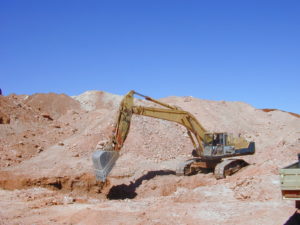FAQ : How is opal mining done? What is noodling? How are opals mined? How is opal mined? What is open-cut mining? How are opals processed?
Opal is one of the few minerals which can be extracted economically by a miner working alone. The simplest form of mining, carried out in the early days of opal mining, is by shaft sinking with a pick and shovel. A shaft is sunk straight down until some promising “opal dirt” is discovered. The miner would then branch out sideways, following the “level” of opal. Driving along the level is carried out with picks and explosives. A handpick or screwdriver is used to delicately extract any opal found, due to the frailty of the stone. Most mining was a two-man operation, one man in the hole and another up top to wind the windlass and haul out the dirt.

Most shafts are now sunk by Calweld-type drills which are used to sink vertical holes about one metre in diameter using an auger bucket. Waste material, or mullock, from the shafts and drives was originally lifted in buckets by hand windlass, but power winches or automatic bucket tippers are now used.
Of course, sinking a hole in recognised opal country offers no certainty of finding what is sought. More than sixty separate ‘fields’ have been worked at Lightning Ridge alone, and each of them has waxed and waned according to what was found. Following “seam opal” on a field such as The Grawin means first locating a seam of the glassy gray “potch” in hopes that at some spot, the potch will suddenly take on the qualities of gem opal. These underground ribbons bend, turn, dip to impossible depths, or simply disappear according to the pressures exerted on the earth long ago. Tantalising hints of those prehistoric times sometimes are uncovered in the form of opalised sea shells or opalised fossils from the days of the dinosaurs.
There has been a rapid increase in the use of mining machines since the 1970s. Tunneling machines with revolving cutting heads and small underground front-end loaders (boggers) have been introduced to streamline opal mining and dramatically increase productivity. Miners soon saw the benefits of technology – drilling test shafts to gauge their chances before beginning serious excavation, using jackhammers instead of pickaxes, blasting with dynamite, or bringing in the bulldozers. Bulldozers are employed to remove overburden and expose the level where it is shallow. Spotters follow behind watching for traces of opal, and any seam found is then worked over by handpick.
Of course, all of these labour savers sometimes end in bitter tears, when the opal is spotted only after it has been shattered. They also increase the cost of equipment and operation.
In Queensland, the majority of mines worked in recent years are large open-cut operations. Overburden is stripped from zones of ironstone boulder concretions. Boulders are carefully removed from the ground for processing. Heavy equipment has been used to open up most areas of old workings. At Yowah, underground methods are still applied with success. Shafts are sunk until a prospective layer is intersected. The layer is then explored by the driving of tunnels. Usually at least two shafts are sunk and connected by drives to allow circulation of air. In areas of underground mining, miners utilise ‘light’ electrical machinery driven by portable generators.
If the boulders show any evidence of opalisation, they are first removed from the mined ground and collected for later inspection for opal content, and sorted in readiness for sale as rough, or for further processing. For boulder opal, some of the ironstone is left attached as a natural backing, producing natural doublets. Other stones are cut from the ironstone matrix containing opal.
The Australian export market for opals has been in decline in recent years, but this trend is likely to be turned around as production increases from existing and new deposits. Australia exports most of its opal to Hong Kong, Taiwan, Japan, USA and Europe.
As most old diggings have now been largely worked out or reworked by open-cut methods, exploration to find new prospects has commenced over known opal bearing country. Well-resourced exploration companies have become involved and are applying more systematic and extensive exploration techniques on a regional scale in the search for new deposits. Positive results have been reported, which should lead to further exploration and new mines.
In addition to the traditional opal fields, exploration for opal has been undertaken in the Hebel-Dirranbandi area near the Queensland – New South Wales border where there is a 70 km northern extension of the Cretaceous Griman Creek Formation, which hosts the Lightning Ridge opal field.
Both shaft and open-cut mining takes place at Lightning Ridge, although shaft-mining is more common due to the way opals on this famous field were formed. “Ridge” opal is encased in rounded formations known as “nobbies”… but not all nobbies contain opal. At Andamooka, “seam opal” is the object of the miner’s search.
Near whatever water is available, an array of concrete mixer trucks is a common site – used to ‘agitate’ (wash and sluice) the opal-bearing material like gigantic washing machines. “Blowers” at some locations suck the opal dirt into trucks at topside, which haul the dirt to the “agitator” for sluicing.
Noodling
Many locals make a living out of searching through heaps of discarded mullock for pieces of precious opal. Noodling machines in which mullock is passed by conveyor under an ultra-violet light in a darkened enclosure are also used. Many people enjoy partaking in this activity during visits to the opal fields, and some do it for a living.
Sources:
- “Opal in South Australia”, Mines & Energy Resources, SA
- “Opal”, Qld Dept. of Mines & Energy
- “Make your own Luck with Opal”, Jewellery World, June 2000.


